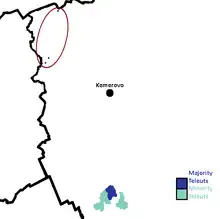Teleuts
Teleuts (Altay: тэлэңэт, тэлэңут, romanized: Telenget, Telengut) are a Turkic Indigenous people of Siberia living in Kemerovo Oblast, Russia.[2] According to the 2010 census, there were 2,643 Teleuts in Russia. They speak the Southern Altai Teleut language/dialect.[3][4]
 | |
| Regions with significant populations | |
| 2,643[1] | |
| Languages | |
| Southern Altai Teleut | |
| Religion | |
| Predominantly Russian Orthodox Minority Sunni Islam, shamanism | |
| Related ethnic groups | |
| Altaians, Chelkans, Khakas, Kumandins, Siberian Tatars, Shors, Tofalar | |
In the Soviet years and until 2000, the authorities considered the Teleuts to be part of the Altai people. Currently, according to the Resolution of the Government of the Russian Federation No. 255 dated March 24, 2000, as well as 2002 and 2010 Russian Census, they are recognized as a separate ethnic group within Indigenous small-numbered peoples of the North, Siberia and the Far East.
History
The Teleuts were once part of the Tiele people. They came under the rule of the First Turkic Khaganate. Near the end of the 16th century, the Teleuts wandered the steppe between the Irtysh and the Ob' rivers. They became nominal subjects to the Oirats at this period. Their population at this time numbered 4,000 tents.[5]
The Russians gained control of the region in the mid-eighteenth century and the Teleuts subsequently became their subjects.[6] The Russians called the Teleuts "White Kalmyks" in their documents despite the ethnic and linguistic differences between the Kalmyks and Teleuts.[5]
The Teleuts consider themselves to be a distinct people and many do not accept being labeled as Altaian.[7] The majority of the Teleuts live along the Great and Little Bachat Rivers in Kemerovo Oblast. However, a few Teleuts also live in the Altai Republic.[5]
Culture
Most Teleuts used to be nomadic or semi-nomadic livestock herders and horses, goats, cattle, and sheep were the most common types of animals they raised. Some Teleuts were hunters and relied on animals living in the taiga for subsistence.[6]
Traditional Teleut dwellings included conic yurts made out of bark or perches.[6]
Common Teleut dress was composed of linen shirts, short breeches, and single-breasted robes.[6]
Religion
Most Teleuts are Orthodox Christians. However, there is a minority that practice shamanism.[6] Burkhanism was once widely practiced by the Teleuts but was effectively eliminated during the Soviet era. Contemporary revivals of the religion among other Altaian groups have not affected the Teleuts.[8] A group of Teleuts at least nominally converted to Islam as early as the 17th century. A minority of Teleuts moved up to the north of Kemerovo Oblast and interacted with local Tatars and became Sunni Muslims. Today they number around 500 and have mostly assimilated while keeping their Teleut roots, into the local Tatars and are known as the Kalmaks also adopting a local dialect of the Tatar language.[5][9][10] However some sources consider the language of the Kalmaks to be a separate variety of Tatar, or even a dialect of the Teleut language, as it differs greatly from other Siberian Tatar varieties.[11][12][13]
See also
References
- Russian Census 2010: Population by ethnicity (in Russian)
- Library of Congress - Classification Web : web link
- Nevskaya I.A. "The Teleut Language". Endangered Languages of Indigenous Peoples of Siberia. UNESCO. Retrieved 2021-07-16.
- Altai Republic - Teleuts (Республика Алтай - Телеуты) : web link Archived 2006-06-14 at the Wayback Machine (in Russian)
- Akiner, Shirin (1986). Islamic Peoples of the Soviet Union (2nd ed.). London: Routledge. pp. 435–436. ISBN 0-7103-0025-5.
- Encyclopedia of the world's minorities. Skutsch, Carl., Ryle, Martin (J. Martin). New York: Routledge. 2005. pp. 82–83. ISBN 1-57958-392-X.
{{cite book}}: CS1 maint: others (link) - Mote, Victor L. (1998). Siberia: Worlds Apart. Boulder, CO: Westview Press. pp. 138. ISBN 0-8133-1298-1.
- Bat'ianova, E. P. (2007). "The Teleut Version of Burkhanism". Anthropology & Archeology of Eurasia. 45 (3): 9–34. doi:10.2753/aae1061-1959450301. ISSN 1061-1959. S2CID 144470983.
- http://haknii.ru/files/magazine/v3/Kimeev_V.M._Krivonogov_V.P._Jetnicheskie_processy_u_kalmakov.pdf
- Nevskaya, Irina (2007), "Ethno-Linguistic Processes in Post-Soviet South Siberia", Cultural Changes in the Turkic World, Ergon Verlag, pp. 107–122, doi:10.5771/9783956506925-107, ISBN 9783956506925
- Уртегешев, Н.С. (2016). "Kalmaksky yazyk" Калмакский язык [The Kalmak language]. Yazyk i obshchestvo. Entsiklopediya Язык и общество. Энциклопедия [Language and society. Encyclopedia] (PDF) (in Russian). Москва: ООО Издательский центр "Азбуковник". pp. 186–189. ISBN 978-5-91172-129-9.
- "Калмакский | Малые языки России". minlang.iling-ran.ru. Retrieved 2022-06-06.
- Уртегешев, Николай С. (2018). "Kalmakov yazyk" Калмаков язык [The language of the Kalmaks]. Tehlikedeki Diller Dergisi. 8 (12): 65–96.
External links
- Association of the Teleut People (in Russian)
- ELAR archive of Documentation and Analysis of the Endangered Teleut Language